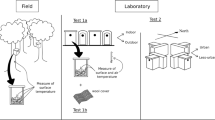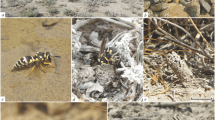Summary
Eggs of the brush turkey (BT) and mallee fowl (MF) are incubated in mounds of soil and plant litter. Humidity in BT mounds is always near saturation (>99% RH), but in MF mounds it drops to lower values in summer (x=77% RH). Despite these high humidities, the eggs lose an average of 9.5% (BT) and 12.0% (MF) of their initial mass by evaporation before hatching. The rate of evaporation\((\dot M_{{\text{H}}_{\text{2}} ^{\text{O}} } )\) increases during incubation several-fold due to large changes in water vapor conductance of the shell\((G_{{\text{H}}_{\text{2}} ^{\text{O}} } )\) and embryonic heat production. Values of\(G_{{\text{H}}_{\text{2}} ^{\text{O}} } \) in fully incubated eggs in mound material are about 3–6 times higher than values obtained from unincubated eggs in desiccators. This effect depends on two factors: (1)\(G_{{\text{H}}_{\text{2}} ^{\text{O}} } \) increases with ambient humidity, especially above 80% RH, possibly because the effective site of evaporation moves out along the walls of the pores in the eggshell. (2) Structural changes of the pores due to calcium absorption by the embryo directly increase\(G_{{\text{H}}_{\text{2}} ^{\text{O}} } \). The first factor is most important in BT eggs and the second is dominant in MF eggs. Production of metabolic heat by the embryo increases the vapor pressure difference across the shell and further increases\(\dot M_{{\text{H}}_{\text{2}} ^{\text{O}} } \), especially in mounds of high humidity. The changes in pore structure are adaptive because they produce high conductances to respiratory gases and cause normal gas tensions within the egg at the end of development, yet\(G_{{\text{H}}_{\text{2}} ^{\text{O}} } \) is low enough in early development to prevent excessive water loss. Water not lost by evaporation or taken up by the embryo is stored and released during hatching. A small amount of mass is lost during incubation by respiratory gas exchange.
Similar content being viewed by others
Abbreviations
- BT :
-
brush turkey
- MF :
-
mallee fowl
- RH :
-
relative humidity
References
Ackerman RA, Seagrave RC (1987) Heat and mass exchange by avian eggs: buried eggs. J Exp Zool (in press)
Ar A, Rahn H (1980) Water in the avian egg: Overall budget of incubation. Am Zool 20:373–384
Ar A, Rahn H (1985) Pores in avian eggshells: gas conductance, gas exchange and embryonic growth rate. Respir Physiol 61:1–20
Ar A, Paganelli CV, Reeves RB, Greene DG, Rahn H (1974) The avian egg: water vapor conductance, shell thickness, and functional pore area. Condor 76:153–158
Baltin S (1969) Zur Biologie und Ethologie des Talegalla-Huhns (Alectura lathami (Gray) unter besonderer Berücksichtigung des Verhaltens während der Brutperiode. Z Tierpsychol 26:524–572
Birchard GF, Kilgore DL Jr (1980) Conductance of water vapor in eggs of burrowing and nonburrowing birds: implications for embryonic gas exchange. Physiol Zool 53:284–292
Booth DT (1985) Ecological physiology of malleefowl (Leipoa ocellata). PhD thesis, The University of Adelaide
Booth DT, Seymour RS (1987) Effect of eggshell thinning on water vapor conductance of malleefowl (Leipoa ocellata) eggs. Condor (in press)
Bucher TL, Barnhart MC (1984) Varied egg gas conductance, air cell gas tensions and development inAgapornis roseicollis. Respir Physiol 55:277–289
Carey C (1979) Increase in conductance to water vapor during incubation in eggs of two avian species. J Exp Zool 209:181–186
Carey C (1980) Adaptation of the avian egg to high altitude. Am Zool 20:449–459
Carey C (1983) Structure and function of avian eggs. In: Johnston RF (ed) Current Ornithology, vol. 1. Plenum Press, New York, pp 69–103
Carey C (1986) Tolerance of variation in eggshell conductance, water loss, and water content by red-winged blackbird embryos. Physiol Zool 59:109–122
Carey C, Rahn H, Parisi P (1980) Calories, water, lipid and yolk in avian eggs. Condor 82:335–343
Chattock AP (1925) On the physics of incubation. Phil Trans R Soc Lond Ser B 213:397–450
Davies TA, Platter-Reiger MF, Ackerman RA (1984) Incubation water loss by pied-billed grebe eggs: adaptation to a hot, wet nest. Physiol Zool 57:384–391
Diamond J (1983) Egg incubation. The reproductive biology of mound building birds. Nature 301:288–289
Drent RH (1975) Incubation. In: Farner DS, King JR (eds) Avian biology, vol 5. Academic Press, New York, London, pp 333–420
Duncker HR (1978) Development in the avian respiratory and circulatory system. In: Piiper J (ed) Respiratory function in birds, adult and embryonic. Springer, Berlin Heidelberg New York, pp 260–274
Frith HJ (1959) Breeding of the mallee fowlLeipoa ocellata Gould (Megapodiidae). CSIRO Wildl Res 4:31–68
Frith HJ (1962) The mallee fowl. Angus and Robertson, Sydney, pp 136
Hanka LR, Packard GC, Sotherland PR, Taigen TL, Boardman TJ, Packard MJ (1979) Ontogenetic changes in watervapor conductance of eggs of yellow-headed blackbirds (Xanthocephalus xanthocephalus). J Exp Zool 210:183–188
Hoyt DF (1979) Osmoregulation by avian embryos: the allantois functions like a toad's bladder. Physiol Zool 52:354–362
Lomholt JP (1976) Relationship of weight loss to ambient humidity of birds eggs during incubation. J Comp Physiol 105:189–196
Lundy H (1969) A review of the effects of temperature, humidity, turning and gaseous environment in the incubator on the hatchability of the hen's egg. In: Carter TC, Freeman BM (eds) The fertility and hatchability of the hen's eggs. Oliver and Boyd, Edinburgh, pp 143–176
Meyer PO (1930) Untersuchungen an den Eiern vonMegapodius ermita. Ornithol Monatsber 38:1–5
Paganelli CV, Rahn H (1984) Adult and embryonic metabolism in birds and the role of shell conductance. In: Seymour RS (ed) Respiration and metabolism of embryonic vertebrates. Dr. W. Junk Publishers, Dordrecht Boston London, pp 193–204
Paganelli CV, Ackerman RA, Rahn H (1978) The avian egg: in vivo conductances to oxygen, carbon dioxide, and water vapor in late development. In: Piiper J (ed) Respiratory function in birds, adult and embryonic. Springer, Berlin Heidelberg New York, pp 212–218
Rahn H (1984) Factors controlling the rate of incubation water loss in bird eggs. In: Seymour RS (ed) Respiration and metabolism of embryonic vertebrates. Dr. W. Junk Publishers, Dordrecht Boston London, pp 271–288
Rahn H, Ar A (1974) The avian egg: incubation time and water loss. Condor 76:147–152
Robinson MD, Seely MK (1980) Physical and biotic environments of the southern Namib dune ecosystem. J Arid Environ 3:183–203
Romanoff AL (1967) Biochemistry of the avian embryo. A quantitative analysis of prenatal development. Wiley, New York
Schmidt-Nielsen K (1983) Animal physiology: adaptation and environment. Cambridge University Press, London
Seymour RS (1984) Patterns of lung aeration in the perinatal period of domestic fowl and brush turkey. In: Seymour RS (ed) Respiration and metabolism of embryonic vertebrates. Dr. W. Junk Publishers, Dordrecht Boston London, pp 319–322
Seymour RS (1985) Physiology of megapode eggs and incubation mounds. Acta XVIIIth Ornithological Congress, Moscow, pp 854–863
Seymour RS, Ackerman RA (1980) Adaptation to underground nesting in birds and reptiles. Am Zool 20:437–447
Seymour RS, Rahn H (1978) Gas conductance in the eggshell of the mound-building brush turkey. In: Piiper J (ed) Respiratory function in birds, adult and embryonic. Springer, Berlin Heidelberg New York, pp 243–246
Seymour RS, Vleck D, Vleck CM (1986) Gas exchange in the incubation mounds of megapode birds. J Comp Physiol 165:773–782
Snyder GK, Birchard GF (1982) Water loss and survival in the embryos of the domestic chicken. J Exp Zool 219:115–117
Sotherland PR, Packard GC, Taigen TL, Boardman TJ (1980) An altitudinal cline in conductance of cliff swallow (Petrochelidon pyrrhonota) eggs to water vapor. Auk 97:177–185
Spotila JR, Weinheimer CJ, Paganelli CV (1981) Shell resistance and evaporative water loss from bird eggs: effects of wind speed and egg size. Physiol Zool 54:195–202
Tøien O, Paganelli CV, Rahn H, Johnson RR (1987) Conductance of the eggshell pore: how does pore shape influence diffusion? J Exp Zool (in press)
Vleck D, Vleck CM, Seymour RS (1984) Energetics of embryonic development in the megapode birds, mallee fowlLeipoa ocellata and brush turkeyAlectura lathami. Physiol Zool 57:444–456
Author information
Authors and Affiliations
Rights and permissions
About this article
Cite this article
Seymour, R.S., Vleck, D., Vleck, C.M. et al. Water relations of buried eggs of mound building birds. J Comp Physiol B 157, 413–422 (1987). https://doi.org/10.1007/BF00691824
Accepted:
Issue Date:
DOI: https://doi.org/10.1007/BF00691824




